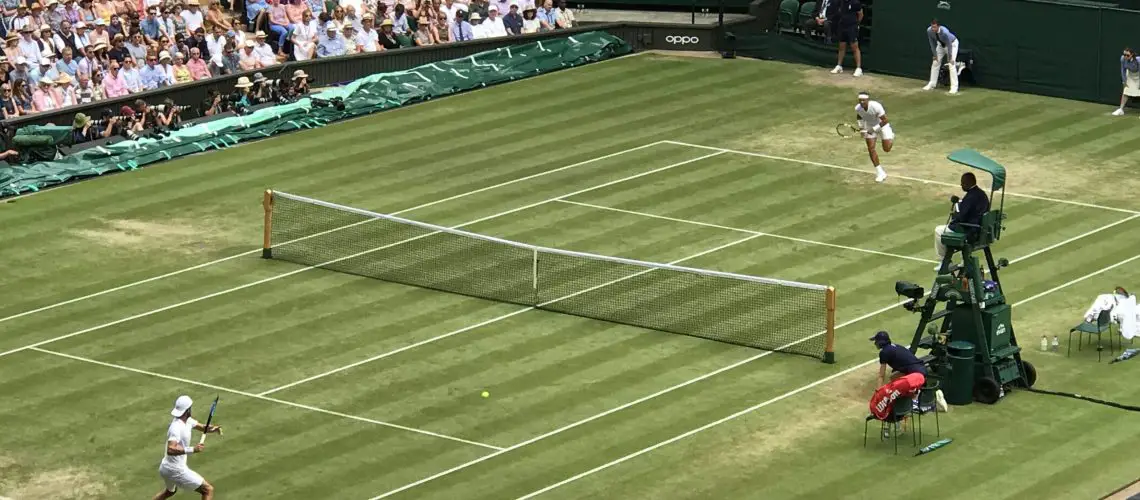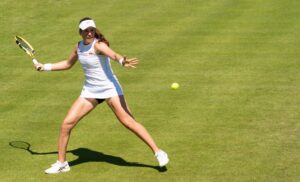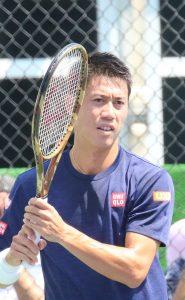We may earn money or products from the companies mentioned in this post.
Introduction to Sports Similar to Tennis

If you’re a fan of tennis and looking to explore other sports that offer similar thrills and challenges, you’ve come to the right place In this article, we’ll provide you with a brief overview of tennis as a sport, including its origins and basic rules We’ll also highlight the importance of exploring sports like tennis for enhancing your skills and expanding your interests
Brief Overview of Tennis as a Sport
Tennis is a popular racket sport played between two individuals (singles) or two teams of two players each (doubles). It has a rich history that dates back centuries, making it one of the oldest sports still played today
The origins of tennis can be traced back to medieval times when it was known as “real tennis” or “royal tennis” The game evolved over time, with modern lawn tennis being developed in England during the late 19th century
In terms of gameplay, the objective in tennis is simple yet challenging – players must hit a ball over a net and into their opponent’s court, aiming to score points by making the ball bounce twice before their opponent can return it The game combines physical agility, strategic thinking, and precise shot-making
Importance of Exploring Sports Like Tennis
1 Enhancing Skills Through Different Sports
Exploring sports similar to tennis provides an excellent opportunity to enhance your skills in various ways By venturing into new sporting arenas, you expose yourself to different physical demands and develop different sets of techniques that can complement your existing abilities in tennis
For instance, if you try out racquetball or squash – both fast-paced racket sports – you’ll improve your reflexes and hand-eye coordination even further Similarly, sports like badminton or table tennis can enhance your agility and footwork, giving you an edge in the tennis court
2 Expanding Interests and Discovering New Passions
When you open yourself up to exploring sports similar to tennis, you not only broaden your skill set but also expand your interests Trying out different sports allows you to discover new passions and find joy in diverse athletic pursuits
You may find that you have a natural talent for a particular sport that you never would have discovered if you hadn’t stepped outside the realm of tennis This newfound passion can bring fresh excitement and motivation to your overall athletic journey
Popular Racket Sports That Resemble Tennis

Badminton
Badminton, with its roots dating back to ancient civilizations in Europe and Asia, has evolved into a widely recognized sport enjoyed by millions around the world Originating in India, badminton was initially called “poona” before gaining popularity in England during the 19th century
In terms of similarities with tennis, badminton shares a similar court layout, where players compete on opposite sides of a rectangular court divided by a net Both sports also utilize rackets to hit the ball over the net and follow a scoring system that awards points based on successful shots
However, there are distinct differences between the two sports Unlike tennis, which uses a ball, badminton employs a shuttlecock made of feathers or synthetic materials Additionally, badminton rackets are lighter and more flexible than their tennis counterparts to accommodate the fast-paced nature of the game The playing style in badminton focuses on agility, quick reflexes, and precise shot placement
Squash
Squash traces its origins back to 19th-century England when it emerged as an indoor alternative to lawn tennis during colder months Over time, squash gained international recognition and became one of the most popular racket sports worldwide
Similar to tennis, squash players use rackets to strike the ball against a front wall within an enclosed court The scoring system follows similar principles as well – players earn points when their opponent fails to return the ball successfully
The key differences lie in the size of the court; squash courts are smaller compared to tennis courts and have unique wall rules that allow for strategic shots off multiple surfaces Additionally, unlike traditional tennis balls made of felt or rubber composite material, squash balls are made of rubber and specifically designed for the fast-paced, intense nature of the game
Table Tennis (Ping Pong)
Table tennis, known colloquially as ping pong, became a popular recreational activity in England during the late 19th century before evolving into a competitive sport Its origins can be traced back to Victorian England and various table-based games played across Europe
Similar to tennis, table tennis involves using rackets to hit a lightweight ball over a net towards an opponent’s side of a rectangular table The scoring system also mirrors that of tennis, with points awarded based on successful shots and errors made by the opposing player
However, there are key differences between tennis and table tennis The playing area in table tennis is significantly smaller, limited to the dimensions of a table rather than a full-sized court Additionally, the balls used in table tennis are much lighter compared to traditional tennis balls, allowing for faster rallies and increased spin
By SEOCONTENTMASTER
Alternative Sports Inspired by Tennis

Padel
Padel, a sport with origins dating back to the late 19th century, has gained popularity as an alternative to traditional tennis It was first introduced in Mexico and later spread to Spain, where it became widely played The game combines elements of tennis and squash, providing a unique and exciting experience for players
In terms of similarities to tennis, padel shares some key features The court layout is similar, divided into two halves by a net Players use rackets to hit the ball over the net and score points according to a similar system
However, there are also distinct differences that set padel apart from tennis The most notable difference is the enclosed court with walls surrounding the playing area This feature adds an extra dynamic to the game as players can use the walls strategically during rallies
Another difference lies in the equipment used Padel rackets have perforated faces instead of strings, which allows for a different style of play Additionally, the court size is smaller than a traditional tennis court, making padel more accessible for beginners or those seeking a faster-paced game
Pickleball
Pickleball is another alternative sport inspired by tennis that has gained widespread popularity in recent years
The sport originated in 1965 on Bainbridge Island, Washington when three friends wanted to create a new game that could be enjoyed by all ages They combined elements of badminton, table tennis, and yes – you guessed it – tennis!
Pickleball shares similarities with tennis when it comes to court layout and scoring system The court is divided into halves by a net just like in tennis, and players aim to score points through strategic shots and well-placed serves
However, there are some key differences that make pickleball unique Instead of using traditional tennis rackets, players use composite paddles which provide a different feel and style of play The ball used in pickleball is a wiffle ball, with holes in it to reduce its speed and allow for better control during rallies
Another aspect that sets pickleball apart is the doubles format While tennis can be played in both singles and doubles, pickleball is predominantly played as a doubles game This adds a social element to the sport, making it an enjoyable activity for friends and families alike
Introduction

Tennis, a popular and globally recognized sport, has a rich history and continues to captivate athletes and enthusiasts alike Understanding its origins and global reach can provide valuable insights into the sport’s significance Additionally, exploring similar sports can contribute to skill enhancement in tennis while also offering new avenues for athletic exploration
Brief Overview of Tennis as a Sport
Tennis dates back to the 19th century when it originated in England Initially known as “lawn tennis,” the game quickly gained popularity due to its competitive nature and accessibility Over time, it evolved from an aristocratic pastime into a widely played sport enjoyed by millions around the world today
Tennis is played on various surfaces such as grass, clay, or hard courts It involves two players (singles) or four players (doubles) competing against each other by hitting a ball over a net using racquets The objective is to score points by strategically placing shots where opponents cannot return them successfully
Popularity and Global Reach
Tennis has achieved remarkable popularity worldwide, attracting fans from diverse backgrounds Major tournaments like Wimbledon, the Australian Open, French Open, and the US Open command global attention and draw top-ranked players who vie for prestigious titles
The appeal of tennis lies in its combination of physical prowess, mental acuity, and strategic gameplay Its exciting matches often feature intense rallies filled with power serves, precise volleys, agile footwork, and strategic shot placement
Importance of Finding Similar Sports to Tennis
Exploring similar sports can significantly benefit tennis players by enhancing their skills both on and off the court Engaging in activities that share similarities with tennis can help develop crucial attributes such as hand-eye coordination, agility, endurance, and strategic thinking
Enhancing Skills in Tennis Through Other Sports
Participating in sports like table tennis, squash, and badminton can enhance a player’s hand-eye coordination and reflexes These sports require quick reactions and anticipation, which are valuable skills in tennis By engaging in these similar activities, tennis players can improve their ability to react swiftly to fast-paced gameplay
Furthermore, sports like basketball or soccer can help develop agility, as they involve rapid changes in direction and quick movements These skills directly translate into better footwork on the tennis court, enabling players to cover more ground efficiently
Exploring Alternative Athletic Interests
While focusing on one sport is essential for skill mastery, exploring alternative athletic interests can provide a well-rounded approach to physical development Trying out other sports such as swimming, running, or cycling not only promotes overall fitness but also prevents burnout by diversifying training routines
Dabbling in different activities exposes athletes to unique challenges that foster adaptability and mental resilience Additionally, cross-training allows individuals to discover new passions while maintaining an active lifestyle outside of tennis
In conclusion,
By understanding the history and global reach of tennis while also exploring similar sports and alternative athletic interests, players can broaden their horizons within the world of sports This holistic approach contributes to skill enhancement while fostering physical and mental growth beyond the confines of a single sport
Padel Tennis: The closest cousin to traditional Tennis

When it comes to racket sports, tennis has always been a popular choice However, there is another sport that closely resembles traditional tennis and offers its own unique twist – padel tennis Padel tennis is gaining popularity worldwide due to its fast-paced nature and exciting gameplay
Defining padel tennis
In padel tennis, players use solid paddles instead of rackets, and the court is enclosed by glass walls and wire mesh These walls come into play during the game, adding an extra dimension of strategy and excitement The equipment used in padel tennis may be different from traditional tennis, but the objective remains the same – to outsmart your opponent and win points
The scoring system in padel tennis also shares similarities with traditional tennis It follows a similar pattern of love (0), 15, 30, 40, and game point To win a set, you must reach six games with a difference of at least two games over your opponent
Differences between padel and traditional tennis
While both sports are played with rackets or paddles on a court divided by a net, there are notable differences between padel and traditional tennis One significant difference lies in the court size A standard padel court is smaller than a traditional tennis court, making it easier for players to cover ground quickly
Another variation can be found in the playing surface itself Traditional tennis courts can have different types of surfaces like grass, clay or hardcourt; whereas padel courts typically have artificial grass or acrylic surfaces that provide consistent bounce throughout the match
Furthermore, one of the most distinctive features of padel is the use of walls during play Unlike in traditional tennis, players can play the ball off the walls in padel, adding an element of surprise and unpredictability This unique rule allows for creative shot-making and strategic placement
Benefits of playing padel for a tennis player
For avid tennis players looking to try something new, padel offers a range of benefits that can enhance their overall game Playing padel improves footwork, reflexes, and coordination due to its fast-paced nature and close-quarters gameplay The enclosed court forces players to react quickly and make split-second decisions
Additionally, playing padel can increase adaptability on different surfaces While traditional tennis may be played on various types of courts, the consistent surface found in most padel courts allows players to develop a solid foundation and adjust their game accordingly
In conclusion, padel tennis is not only an enjoyable sport but also a great way for tennis enthusiasts to explore a new dimension of the game With its similarities to traditional tennis paired with unique elements like using walls during play, it offers an exciting alternative for both casual players and competitive athletes alike
Badminton: The fast-paced racket sport alternative

Defining badminton as a sport
When it comes to sports, badminton stands out as a thrilling and dynamic option Unlike other racket sports, badminton is played with a unique object called the shuttlecock or birdie This feathered projectile adds an exciting element to the game, with its unpredictable flight path and ability to be hit at incredible speeds
In addition to its distinctive playing object, badminton also has its own set of rules and scoring system Players volley the shuttlecock back and forth across a net, aiming to keep it from touching the ground on their side of the court Points are scored when opponents fail to return the shuttlecock successfully or commit faults, adding an element of strategy and skill to the game
Comparing badminton with traditional tennis
While both badminton and traditional tennis share similarities in stroke technique, such as forehand and backhand shots, there are notable differences that set them apart In badminton, players rely on quick reflexes and precise shots due to the fast-paced nature of the game Tennis, on the other hand, allows for more powerful strokes due to its larger court size
Another key difference lies in gameplay strategy In tennis, players focus on court positioning and rallying tactics over long distances In contrast, badminton requires players to constantly adapt their positioning based on their opponent’s movements in order to gain an advantage Additionally, serving styles differ between these two sports; tennis serves are usually overhead while in badminton they are often performed underhand
Advantages of incorporating badminton into a regular practice routine
Incorporating badminton into a regular practice routine offers numerous benefits for athletes of all levels One advantage is the development of faster reaction times The fast-paced nature of badminton forces players to react quickly to incoming shots, improving their reflexes and hand-eye coordination
Furthermore, playing badminton helps build endurance and agility The constant movement, quick changes in direction, and explosive bursts of speed required during gameplay contribute to improved cardiovascular fitness and overall physical conditioning
Introducing Pickleball: The Fun Fusion of Tennis, Badminton, and Table Tennis

Looking for a new and exciting racket sport? Look no further than pickleball! This unique game combines elements from tennis, badminton, and table tennis to create a fun and fast-paced experience that is quickly gaining popularity
1 Explanation of the Court Setup
Pickleball is typically played on a court that resembles a smaller version of a tennis court The dimensions are 20 feet wide and 44 feet long The court is divided into two halves by a net, similar to tennis However, what sets pickleball apart is the non-volley zone or “kitchen” area, located on both sides of the net
2 Equipment Requirements
To play pickleball, you’ll need some basic equipment First and foremost, you’ll need a pickleball paddle, which is similar to a small-sized tennis racket but with distinct characteristics Additionally, you’ll need a perforated plastic ball with holes (similar to a Wiffle ball) designed specifically for pickleball
Connections between Pickleball and Traditional Tennis

Pickleball shares some similarities with traditional tennis techniques and gameplay strategies Let’s explore these connections:
1 Volleying Techniques
In both pickleball and tennis, volleying plays an essential role in the game Players must learn to hit the ball before it bounces on their side of the net Mastering volleying techniques in pickleball can enhance your skills in tennis as well
2 Similarities in the Service Action
The service action in both sports requires precision and strategy While there are some differences in the serving rules, the overall motion and importance of a solid serve remain consistent Tennis players can use their knowledge of serving to quickly adapt to pickleball
Why Tennis Players Should Try Pickleball

If you’re a tennis player looking for a new challenge or simply want to diversify your racket sport skills, here’s why you should give pickleball a try:
1 Enhancing Hand-Eye Coordination and Speed
Pickleball is known for its fast-paced rallies and quick reflexes Playing pickleball can help improve your hand-eye coordination as you react swiftly to make precise shots The rapid exchanges in pickleball will also enhance your speed on the court
2 Increasing Versatility as a Player
By adding pickleball to your repertoire, you’ll become a more versatile player overall The unique dimensions of the court and different gameplay strategies in pickleball will challenge you to think differently and adapt your skills accordingly This newfound versatility can benefit your performance in other racket sports, including tennis
Useful Links

America’s fastest growing sport is a cross between tennis …
What is Pickleball? Learn the basics.
Tennis Vs Volleyball: Comparing Two Unique Sports
What Is the Difference Between Pickleball and Tennis?
Pickleball vs Tennis – Differences and Similarities
12 Sports Similar to Pickleball (Alternatives) – PickleVine.com –
What are the differences and similarities between pickleball …
10 Alternatives to Playing Tennis – Do Not Ditch the Racquet!
What is Padel Tennis?
What Sports Are Similar To Pickleball? | Paddle2Racket
Paddle Sports
Sport Similar to Tennis: Let’s Find Out What Alternatives Exist
Is padel tennis the next pickleball? – Quartz
Why is it called Pickleball? | Is P-Ball Fun?
Forget pickleball — Padel is our new favorite weird sport
SPORTS & GAMES :: RACKET SPORTS images
Paddle Tennis the Sport
Pickleball & Tennis: Match Made in Sports Court Heaven
10 Sports Similar to Pickleball-Find Your Next Alternative!






